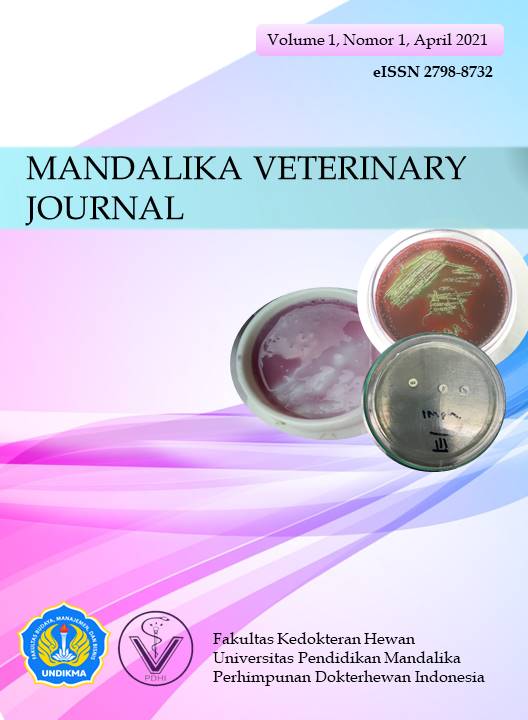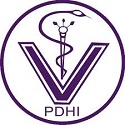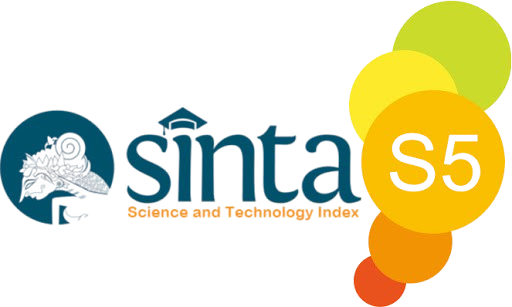Prevalensi dan Derajat Infeksi Helminthiasis Gastrointestinal pada Sapi Bali (Bos sondaicus) di Peternakan Rakyat Mutu Desa Sepayung Kecamatan Plampang Kabupaten Sumbawa Besar Nusa Tenggara Barat
DOI:
https://doi.org/10.33394/mvj.v1i1.3605Abstract
Sumbawa Besar. Healthy cows that are in a state or physiological body functioning normally, which means
that cattle avoid various diseases, especially Helminthiasis. The purpose of this study was to determine the
prevalence and degree of gastrointestinal helminthiasis infection in Balinese cattle (Bos sondaicus) in Mutu
People's Farms in Sepayung village, Plampang sub-district, Sumbawa Besar district, NTB. This research is a
descriptive study with Based on Rates or calculation of the prevalence rate and degree of Gastrointestinal
Helminthiasis infection in bali cattle feces at Mutu People's Farm in Sepayung Village, Plampang District,
Sumbawa Besar Regency, West Nusa Tenggara. This research was conducted in February 2020 in the
Laboratory of the Faculty of Veterinary Medicine, West Nusa Tenggara University, examined using the Mc
Master method and counted the number of worm eggs per gram of feces. Based on the results of laboratory
tests conducted on 37 bali cattle feces samples, found 6 samples infected with Trichostrongylus sp. and 2
samples were infected with Ostertagia sp. The results of examinations that have been done, the prevalence
found in this study is Trychostrongylus 16.21% while in Ostertagia it is 5.40% with the degree of infection in
Trichostrongylus moderate infections and in mild infections Ostertagia. Based on the results of laboratory
tests conducted on 37 bali cattle feces samples, found 6 samples infected with Trichostrongylus sp. and 2
samples were infected with Ostertagia sp. The results of examinations that have been done, the prevalence
found in this study is Trychostrongylus 16.21% while in Ostertagia it is 5.40% with the degree of infection in
Trichostrongylus moderate infections and in mild infections Ostertagia. Based on the results of laboratory
tests conducted on 37 bali cattle feces samples, found 6 samples infected with Trichostrongylus sp. and 2
samples were infected with Ostertagia sp. The results of examinations that have been done, the prevalence
found in this study is Trychostrongylus 16.21% while in Ostertagia it is 5.40% with the degree of infection in
Trichostrongylus moderate infections and in mild infections Ostertagia.
References
BPS Sumbawa. 2018. Populasi Ternak di Kabupaten Sumbawa Menurut Kecamatan, 2018.
https://sumbawa.bps..go.id/dynamictable/2019/11/29/267/populasiternak-dikabupaten-sumbawa-menurut-kecamatan-2018.html. [10 Desember 2019]
Koesdarto, S., S. Subekti, S. Mumpuni, H. Puspitawati dan Kusnoto. 2007. Buku Ajar Ilmu
Penyakit Nematode Veteriner. Fakultas Kedokteran Hewan Universitas Airlangga.
Surabaya.
Mastra, I.K., N.K.H. Saraswati, I.M. Sutawijaya dan Yunanto, 2014. Surveilan dan Monitoring
Parasit Gastrointestinal pada Sapi Bali di Provinsi Bali, Nusa Tenggara Barat dan
Nusa Tenggara Timur. Dalam: Laporan Teknis Hasil Survailans dan Monitoring di
Wilayah Kerja Balai Besar Veteriner Denpasar Tahun 2014. Balai Besar Veteriner
Denpasar. p. 76-87.
Purwantan, P., Ismaya N.R., Burhan. 2006. Penyakit Cacing Hati (Fasciolasis) Pada Sapi Bali di
Perusahaan Daerah Rumah Potong Hewan (RPH) Kota Makassar. Jurnal
Agrisistem, 2(2).
Shah-Fischer, M, and Ralph-Say, R, (2015): Manual of tropical Veterinary Parasitology. United
Kingdom. Pp. 137-140.
Stevenson, M., 2008. An Introduction to Veterinary Epidemiology. Massey University,
Palmerston North, New Zealand.
Tjahja I, Husniati. 2012. Berbagai Penyakit Pada Sapi. PT Citra Aji Parama.Klaten.
Downloads
Published
How to Cite
Issue
Section
Citation Check
License
Authors who publish with this journal agree to the following terms:
- Authors retain copyright and grant the journal right of first publication with the work simultaneously licensed under a Creative Commons Attribution License that allows others to share the work with an acknowledgement of the work's authorship and initial publication in this journal.
- Authors are able to enter into separate, additional contractual arrangements for the non-exclusive distribution of the journal's published version of the work (e.g., post it to an institutional repository or publish it in a book), with an acknowledgement of its initial publication in this journal.
- Authors are permitted and encouraged to post their work online (e.g., in institutional repositories or on their website) prior to and during the submission process, as it can lead to productive exchanges, as well as earlier and greater citation of published work (See The Effect of Open Access).





